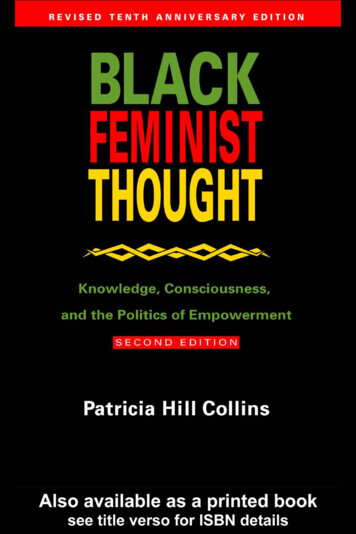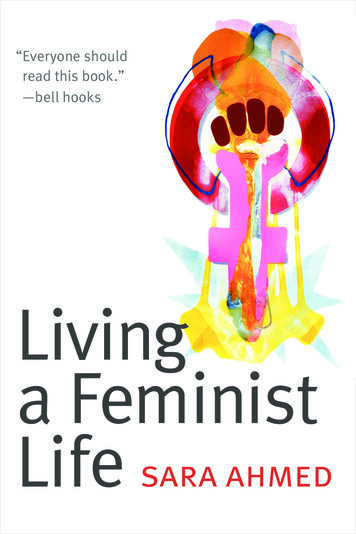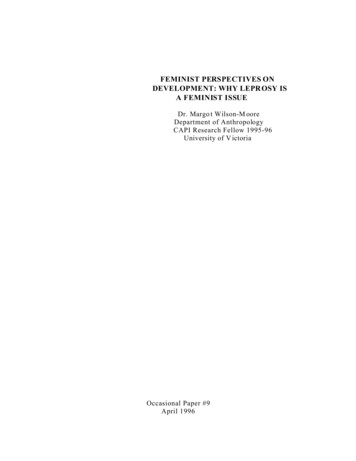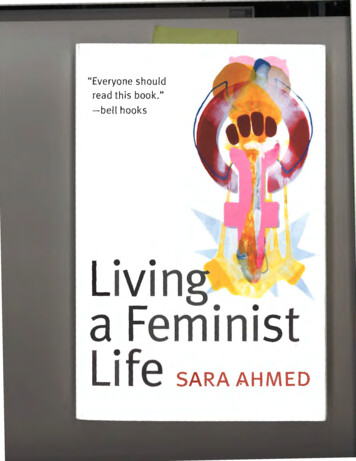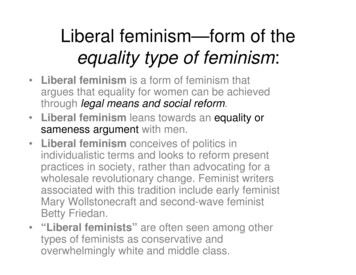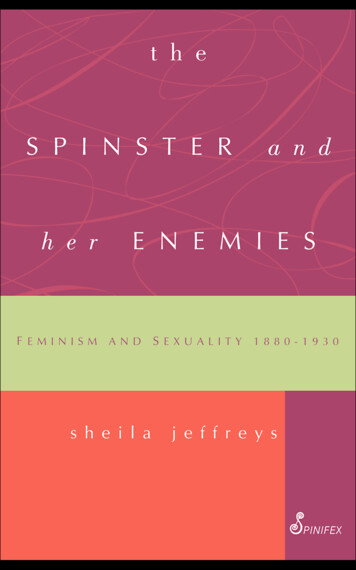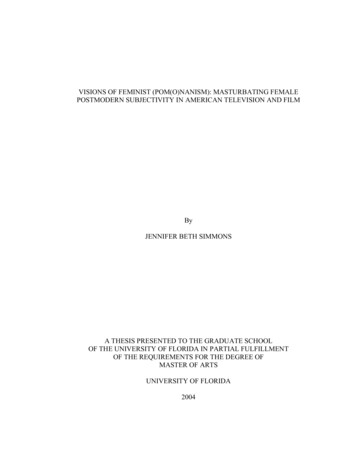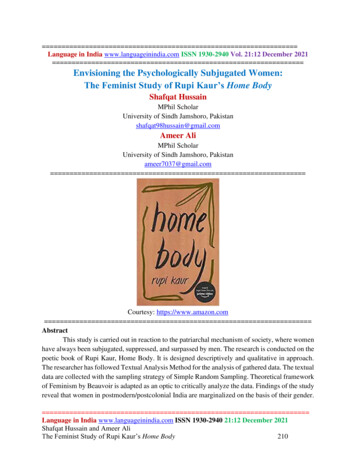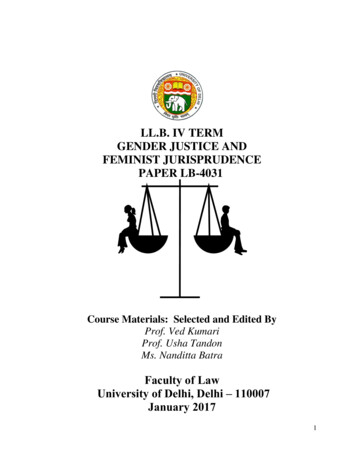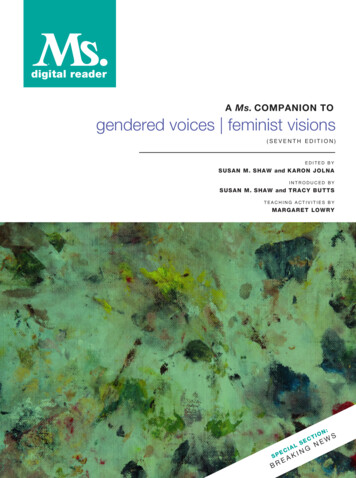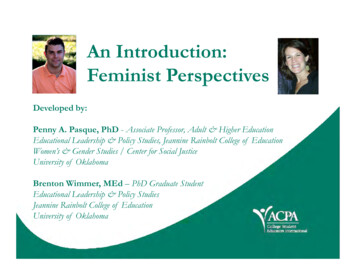
Transcription
An Introduction:Feminist PerspectivesDeveloped by:Penny A. Pasque, PhD - Associate Professor, Adult & Higher EducationEducational Leadership & Policy Studies, Jeannine Rainbolt College of EducationWomen’s & Gender Studies / Center for Social JusticeUniversity of OklahomaBrenton Wimmer, MEd – PhD Graduate StudentEducational Leadership & Policy StudiesJeannine Rainbolt College of EducationUniversity of Oklahoma
Background InformationThis presentation was grant-funded by the ACPA Commission for ProfessionalPreparation. It focuses on the below two readings and is available fordownload in the hopes that people will utilize this information in graduatepreparation programs and professional development programs.Pasque, P. A. & Errington Nicholson, S. (Eds.) (2011). Empowering women in highereducation and student affairs: Theory, research, narratives and practice from feministperspectives. Sterling, VA: Stylus and the American College PersonnelAssociation.Pasque, P. A. (2011). Women of color in higher education: Theoretical perspectives.In G. Jean-Marie and B. Lloyd-Jones (Eds.) Women of Color in HigherEducation: Turbulent Past, Promising Future, Vol. 9. (pp. 21-47). Bingley, UK:Emerald.
Agenda Definitions of Feminism Biological Sex vs. Gender Exercise Types of Oppression Brainstorm Exercise Waves of Feminism Questions for Discussion Conceptualizations of Feminism Exercise Action Strategies for Campus References
What is feminism?In Feminism Is for Everybody: Passionate Politics, bell hooks (2000) shares her “simpledefinition” of feminism:“Feminism is a movement to end sexism,sexist exploitation, and oppression” (p. viii). Feminism is a complex notion that has vast differences in meaning andconnotation for people spanning generations, ethnic identities, sexualorientations, social classes, nationality, and myriad identities. Feminism is not a static notion; rather it evolves withus throughout our lives and is shaped by the variouslenses we use to view the world at large and,most importantly, ourselves.
Feminism & TheoryFeminist theory is founded on three main principles (Ropers-Huilman,2002).1.Women have something valuable to contribute to every aspect ofthe world.2.As an oppressed group, women have been unable to achieve theirpotential, receive rewards, or gain full participation in society.3.Feminist research should do more than critique, but should worktoward social transformation.
Biological Sex vs. Gender Biological Sex refers to the physiological and anatomicalcharacteristics of maleness and/or femaleness with which a person isborn. Gender Identity refers to one’s psychological sense of oneself as amale, female, gender transgressive, etc. Gender Role refers to the socially constructed and culturallyspecific behavior and expectations for women (i.e. femininity)or men (i.e. masculinity) and are based on heteronormativity. Gender Expression refers to the behavior and/or physicalappearance that a person utilizes in order to express theirown gender. This may or may not be consistent withsocially constructed gender roles.(Adams, M., Bell, L. A., & Griffin, P., 1997;Hackman, 2010)
Classroom ExerciseSex & Gender Visual Representations (30 Minutes)Instructions: Provide each person with markers and newsprint. Ask everyone to fold thepaper into four quadrants. Instruct each person to draw the answers to each question withineach quadrant. When finished, discuss the answers in small or large groups.Quadrant 1: Draw the first time you remember noticing/becoming aware of biological sex.Quadrant 2: Draw the first time you remember noticing/becoming aware of gender identity, gender roles,and/or gender expression.Quadrant 3: Draw a picture of your own sex and/or gender as you personify it within the field of studentaffairs and higher education.Quadrant 4: Draw a picture of sex and/or gender as you feel students personify it within your functionalarea of student affairs or higher education (this could be the majority of students in your area or not – itis your choice).
Classroom ExerciseSex & Gender Drawings (30 Minutes)Discussion Questions: Describe the pictures you have drawn within each quadrant. How is biological sex, gender identity, gender roles, and/or gender expression easyand/or difficult for you in student affairs and higher education? How is biological sex, gender identity, gender roles, and/or gender expression easyand/or difficult for undergraduates at your institution? In what ways are the pictures that people in the room drew similar to or differentfrom each other? In what ways are constructions of gender useful and/or problematic in studentaffairs and higher education? What might you do in order to help your colleagues and undergraduates exploremore about their own conceptualizations of sex and gender?
Types of Oppression Individual: Attitudes and actions that reflect prejudice against a socialgroup. Institutional: Policies, laws, rules, norms, and customs enacted byorganizations and social institutions that disadvantage some socialgroups and advantage other social groups. These institutions includereligion, government, education, law, the media, and health caresystem. Societal/Cultural: Social norms, roles, rituals, language,music, and art that reflect and reinforce the belief thatone social group is superior to another.Societal /CulturalInstitutional(Hardiman, Jackson & Griffin, 2010)Individual
The Three Waves of Feminism The history of feminism is often described in three temporal waves. This concept originated with the Irish activist Frances Power Cobbe in 1884 whoshared that movements “resemble the tides of the ocean, where each wave obeysone more uniform impetus, and carries the waters onward and upward along theshore” (as cited in Hewitt, 2010, p. 2). When viewing feminism through the metaphor of a wave, it is important tounderstand that this idea of uniform and monolithic waves is often reductive andignores multiple and often simultaneous movements within and across race,ethnicity, nationality, class, etc. As such, it disregards bravery of women around theglobe prior to the nineteenth century.
The First Wave The First Wave occurred during the nineteenth and early twentieth centuries. It involved some of the foremothers of liberal feminism such as Elizabeth CandyStanton and Matilda Joslyn Gage who, in advocating for divorce laws to protect therights of women, cited Iroquois laws that ensured a man provided for his family onpain of banishment. There was a strong influence of Native American women with whom whitewomen shared land. The pioneers of the women’s movement took cues from NativeAmerican ancestors such as the Iroquois system of election, whereby women chosetheir governmental representative from among eligible men.
The Second Wave The Second Wave occurred during the 1960’s and 1990’s. It unfolded in the context of the antiwar and civil rights movements and thegrowing self-consciousness of a variety of marginalized groups around the world. The Second Wave differed from the First Wave in that it “drew in women of colorand developing nations, seeking sisterhood and solidarity and claiming ‘women’sstruggle as class struggle’” (Rampton, 2008, para 8). Some notable events during this period include the passage of Title VII of theCivil Rights Act of 1964, the formation of the National Organization for Women,passage of Title IX in the Education Amendments of 1972, the Roe v. Wade decision,and the publication of The Feminine Mystique by Betty Friedan.
The Third Wave The Third Wave is considered as the timeframe from 1990’s to present day. It is informed by postcolonial and postmodern thinking. Third Wavers often mystifies earlier feminists as many have reclaimed lipstick, highheals, and cleavage. In addition, tattoos may adorn current day feminists. This wave breaks constraining boundaries of gender, including what it deemsessentialist boundaries set by the earlier waves. Controversy and disagreement around identity politics between feminists in thethird wave have escalated.
Questions for Discussion What questions do you have for women from each wave? Whymight it be useful to ask these questions? Is there a way to research theanswer to your questions? Why do you think some people argue that “waves” of feminism arereductive? Talk about the controversies between feminists today. Morespecifically, why do some women who have tattoos, show cleavage,and enjoy high heals consider themselves feminists whereas someargue that this form of gender expression is not reflective of feministideals? In your opinion, is there a right answer – why or why not?
Conceptualizations of Feminism There are many different conceptualizations, orvariations, of feminism. Though not all inclusive by far, this presentation providesa basic introduction to some of these differentperceptions of feminism. Some of these perspectives are congruent with eachother, some build off of each other, and some are instrict opposition to each other. We encourage you toread about these and additional feministperspectives beyond this presentation.
Liberal Feminism Liberal feminism is a traditional perspective that was established as a part of thefirst wave of feminism. It is often the root of comparison when deconstructingcontemporary conceptualizations of feminism. It argues that “society has a false belief that women are by nature less intellectuallyand physically capable than men” (Tong, 2009, p. 2). This perspective seeks to level the playing field that would allow women to seekthe same opportunities as men, especially the opportunity to excel in various fields. Modern liberal feminists argue that patriarchal society fuses sex and gendertogether, making only those jobs that are associated with the traditionally feminineappropriate for women to pursue.
Radical Feminism Radical feminism is the second most notable form of feminism. Radical feminists think liberal feminist perspectives are not drasticenough to address the centuries of individual, institutional, andsystemic oppression that have ensued. This can be further deconstructed into two types: Libertarian radical feminism focuses on personal freedom of expression butalso turns to androgyny as an option. Cultural radical feminism expressly argues that the root cause of theproblem is not femininity, but the low value that patriarchy assigns to femininequalities. If society placed a higher value on feminine qualities, then there wouldbe less gender oppression. In this way, the volume should be ‘turned up’ on allforms of gender expression – androgyny, femininity, masculinity, and multipleforms of gender expression that is – or is not – congruent with biological sex.
Marxist/Socialist Feminism This lens on feminism incorporates perspectives of social justice as well associoeconomic differences. For many centuries women were considered the property of men and a keycog in the capitalist machine from a commodities perspective. Marxist feminists argue that the path to gender equality is led by thedestruction of our capitalist society. This perspective speaks out to issuessuch as unequal pay, obstacles to achieving tenure or excelling in certainfields, and the frequent lack of family-friendly policies at many of theinstitutions and national organizations of higher education. Socialist feminists purport that women can only achieve true freedom whenworking to end both economic and cultural oppression.
Black/Womanist Feminism Wheeler (2002) defined a Black feminist asa person, historically an African American woman academic, who believes that femaledescendants of American slavery share a unique set of life experiences distinct fromthose of black men and white women the lives of African American women areoppressed by combinations of racism, sexism, classism, and heterosexism. (p. 118) The term Womanist is often used to describe the experiences of a womanof color, including the intersections of race and gender. The Black Womanist feminism (or Black Feminist Thought) movementcomes out of the feminist movement of the 1970’s and is a direct interfacewith the civil rights movement, as it recognizes that women of Africandescent in the U.S. faced a unique set of issues that were not being addressedby the predominantly white feminist movement.
Chicana FeminismChicana feminism is in various stages of development . . . It is recognition that women areoppressed as a group and are exploited as part of la Raza people. It is a direction to be responsibleto identify and act upon the issues and needs of Chicana women. Chicana feminists are involved inunderstanding the nature of women’s oppression. (Nieto Gómez, 1971, p. 9) The El Movimiento drew strong in the 1960’s and 1970’s. Chicana feminism was castas a threat to the notion of la familia and the “institution of Machismo”. Chicana feminism was often viewed as a divisive force. Men, and some women,construed the feminist perspective as a threat that came from outside, from whitewomen, and not necessarily relevant to the Chicana community. With the growth of Chicana feminist awareness and liberation grew a questioningof the “machismo” perspective, discrimination in education, the role of the CatholicChurch, and the ways in which the culture continued to repress women.
Native American FeminismFor Native American women, the struggle for survival has specific challenges since the colonizingculture (western culture) brought misogyny with it and all the religious, social, and judicial restraintsa woman-persecuting society engenders. Therefore, not only do Native American women have to facethe battles any colonized people must meet, but they must fight the beliefs that render themsubordinate because they are women. This dynamic runs entirely counter to the historic and culturalbeliefs of gynocratic indigenous people, so the blow to women because of their gender is particularlysevere. (Sellers, 2008, p. 107) Native American feminism addresses sexism and promotesindigenous sovereignty simultaneously. This perspective places a focus on the preservation of culturalidentity and the role women play within the tribe as the keepers of thatidentity, thus insuring the culture is subsequently passed on to futuregenerations.
Asian-American Feminism Lingyan Yang (2003) defines Asian American feminism as “paying particularly [sic]attention to Asian American women’s voices, texts, experiences, literature, arts, visualarts, histories, geography, theory, epistemology, pedagogy, sexuality, body and life”(p. 141). It includes women in the U.S. whose ancestors are from a number of countriesthroughout Asia (including East Asia, South Asia, and Southeast Asia) as well asmulti-racial women. Throughout centuries of colonization, Western values and educational norms werepressed upon Indigenous people and educational systems of South and East Asia,the Americas, Africa and Australia. Postcolonial researchers and philosophers continue to re-examine the relationshipsbetween oppressor and oppressed, from invasion and conquest, to anti-colonialresistance, to the ongoing legacy of dominance.
Arab American FeminismIt should be made clear – as history and empirical research attest – that the feminismsMuslim women have created are feminisms of their own. They were not “Western;” theyare not derivative. Religion from the very start has been integral to the feminisms thatMuslim women have constructed, both explicitly and implicitly. (Badran, 2009, p. 2) Arab American feminism often addresses key issues of politics andmodernity, East/West relations, religion, colonization, andrelationships between and across gender and class. Muslim women have historically favored two major feministparadigms: Secular feminism and Islamic feminism.
Existential Feminism Simone de Beauvoir (1952) developed another conceptualization offeminism – existentialist feminism. This type of feminism puts forth the knowingly controversial ideathat prostitution empowers women both financially and within thegeneral hierarchy of society. When compared to Marxist and socialistfeminism, the contrast with this type of entrepreneurial spirit isdistinct. Central to this perspective is the concept that one is not born awoman but becomes a woman. de Beauvoir emphasizes that womenmust transcend their natural position and choose economic, personal,and social freedom.
Multicultural Feminism Multicultural feminists suggest that in a nation like the UnitedStates every woman has different intersecting identities andtherefore, is not alike with any other woman. This lens on feminism takes into account a number of differentinterconnected identities and influences; it is sometimes utilized asan umbrella through which many various perspectives can beconsidered. Notably, some argue that this is not a useful umbrella for myriadfeminist perspectives that are historically and culturally distinct, as itcollapses groups and divorces itself form a focus on a specific race,geographic region, and/or unifying language.
Eco Feminism Eco Feminism is the recognition of the common ground in bothfeminism and environmentalism. This is a natural pairing as eco feminists argue that there is acorrelation between the destruction of the planet and theexploitation of women worldwide by the patriarchy. This particular area of feminism intersects with issues ofsocioeconomic privilege, speciesism, and racism. Eco feminists contend that both the destruction of the planet andits inhabitants are at stake, and the only way to avert these disastersis through taking a feminist perspective of the world.
Postmodern Feminism This lens on feminism originated out of what some term the “thirdwave” of feminism.Olson (1996) stated that postmodern feminists,see female as having been cast into the role of the Other. Theycriticize the structure of society and the dominant order, especiallyin its patriarchal aspects. Many Postmodern feminists, however,reject the feminist label, because anything that ends with an “ism”reflects an essentialist conception. Postmodern Feminism is theultimate acceptor of diversity. Multiple truths, multiple roles,multiple realities are part of its focus. There is a rejectance of anessential nature of women, of one-way to be a woman. (p. 19)
Classroom ExerciseSmall Group Discussions (30 Minutes)Instructions: Divide the class into small groups. Discuss thefollowing questions: Which feminist perspective/s resonated with you the most andwhy? Some say “feminism” is “the other ‘F’ word” – what are thepositive / negative definitions of feminism on campuses today? How do you define feminism? In what ways does feminism, sexism and/or patriarchy show up onyour campus (e.g. what are individual actions, specific organizations,and/or institutional policies, that you can identify; what is thegender of your academic deans vs. student affairs deans)? In what ways can men and transgender people be feminists?
Classroom ExerciseStrategies for Change (30 Minutes)Instructions: Since sexism has many different manifestations, there are many waysto can work against it in our own lives. Take some time to brainstorm:1. The various ways people have worked for women’s rights and social changethroughout history, including contemporary society.2. The various ways to address “individual/interpersonal” sexism on your collegecampus.3. The various ways to address sexism “institutional” and/or “societal/cultural”sexism on your college campus.(Adams, M., Bell, L. A., & Griffin, P., 2007)
Interactive Discussion toward ActionDiscussion Questions:1. What action do you want to take to interrupt or combat sexism on your campus?2. What resources or materials, if any, would you need to achieve the goal?3. What hazards or risks are involved? (If too risky, such as you might lose your job and youneed your current income for survival, then go back to the beginning & select again).4. What obstacles might you encounter?5. What supports do you have?6. Where could you find more support?7. How might you measure or evaluate success?(Adams, M., Bell, L. A., & Griffin, P., 2007)
ReferencesAbu-Lughod, L. (1998). Feminist longings and postcolonial conditions. In L. Abu-Lughod (ed.), Remaking women: Feminism and modernity in the middle east. (pp. 3-31). Princeton, NJ: PrincetonUniversity Press.Adams, M., Bell, L. A., & Griffin, P. (2007). Teaching for diversity and social justice (2nd ed.). New York, NY: Routledge.Badran, M. (2009). Feminism in Islam: Secular and religious convergences. Oxford, England: Oneworld.Better, A. S. (2006). Feminist methods without boundaries. Paper presented at the annual meeting of the American Sociological Association, Montreal Convention Center, Montreal, Quebec,Canada.Crossley, M. & Tikly, L. (2004). Postcolonial perspectives and comparative and international education: a critical introduction. Comparative Education, 40(2), p. 147-156.de Beauvior, S. (1952). The second sex. New York, NY: Vintage Books.Hackman, H. (2010). Sexism. In B. Adams, Castaňeda, Hackman, Peters & Zúňiga (Eds.), Readings for diversity and social justice (pp. 315-320). New York, NY: Routledge.Hardiman, R., Jackson, B. W., & Griffin, P. (2010). Conceptual foundations. In B. Adams, Castaňeda, Hackman, Peters & Zúňiga (Eds.), Readings for diversity and social justice (pp. 26-35). NewYork, NY: Routledge.hooks, B. (2000). Feminism is for everybody: Passionate politics. Cambridge, MA: South End Press.Hewitt, N. A. (2010). Introduction. In N. A. Hewitt (Ed.), No permanent waves: Recasting histories of U.S. feminism (pp. 1-14). New Brunswick, NJ: Rutgers University Press.Kochiyama, Y. (1997). Preface: Trailblazing in a white world: A brief history of Asian/Pacific American women. In S. Shah (ed). Dragon ladies: Asian American feminists breathe fire,(pp. v-viii).Boston, MA: South End Press.Naber, N. (2006). Arab American femininities: Beyond Arab virgin / American(ized) whore. Feminist Studies, 32(1). 87-111. Nieto Gómez, A. (1971). Chicanas identify. Regeneración. 1(10). 9.Olson, H. (1996). The power to name: Marginaliza-tions and exclusions of subject representation in library catalogues. Unpublished dissertation. University of Wisconsin-Madison.Pasque, P. A. (2011). Women of color in higher education: Theoretical perspectives. Women of Color in Higher Education: Turbulent Past, Promising Future, Vol. 9. (pp. 21-47). Bingley, UK:Emerald Press.Pasque, P. A. & Errington Nicholson, S. (Eds.) (2011). Empowering women in higher education and student affairs: Theory, research, narratives and practice from feminist perspectives. Sterling, VA: Stylus andAmerican College Personnel Association.
ReferencesRamazanoğu. C. (with Holland, J.). (2002). Feminist methodology: Challenges and choices. Thousand Oaks, CA: Sage.Rampton, M. (2008). Three waves of feminism. The magazine of Pacific University. Retrieved on September 12, 2009 from http://www.pacificu. Huilman, B. (Ed.). (2003). Gendered futures in higher education: Critical perspectives for change. Albany, NY: SUNY.Roth, B. (2004). Separate roads to feminism: Black, Chicana, and White feminist movements in America's second wave. New York, NY: Cambridge University Press.Sellers, S. A. (2008). Native American women’s studies: A primer. New York, NY: Peter Lang.Smith, A. (2007). Native American feminism, sovereignty and social change. In J. Green (ed.), Making space for Indigenous feminism (pp. 93-107). New York, NY: Zed Books.Tong, R. (2009). Feminist thought: A more comprehensive introduction. Philadelphia, PA: Westview Press.Vidal, M. (1997). New voice of La Raza: Chicanas speak out. In A. M. García (ed.), Chicana feminist thought: The basic historical writings (pp. 21-24). New York, NY: Routledge.Wheeler, E. (2002). Black feminism and womanism. In A. M. Martınez Aleman, & K. A. Renn (eds.) Women in higher education: An en- cyclopedia (p. 118–120). Santa Barbara, CA: ABC Clio.Whelehan, I. (2000). Feminism, postmodernism, and theoretical developments. In J. Glazer-Raymo, B. K. Townsend, & B. Ropers-Huilman (eds.) Women in higher education: A feminist perspective(2nd ed; pp. 72–84). Boston, MA: Pearson.Yang, L. (2003). Theorizing Asian America: On Asian American and postcolonial Asian diasporic women intellectuals. Journal of Asian American Studies. 5(2). 139-178.All photos are copyrighted and available through either the American College Personnel Association or the Free Use section on http://www.flickr.com.
download in the hopes that people will utilize this information in graduate preparation programs and professional development programs. Pasque, P. A. & ErringtonNicholson, S. (Eds.) (2011). Empowering women in higher Background Information education and student affairs: Theory, research, narratives and practice from feminist
